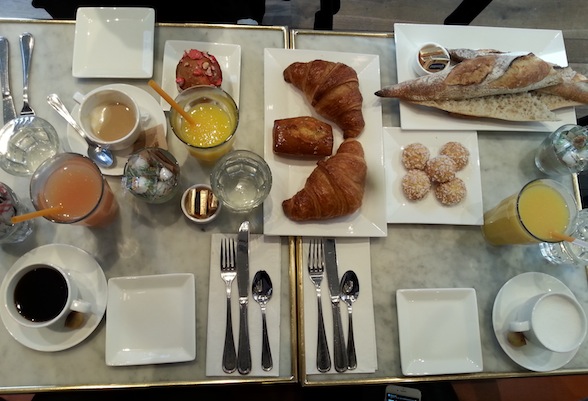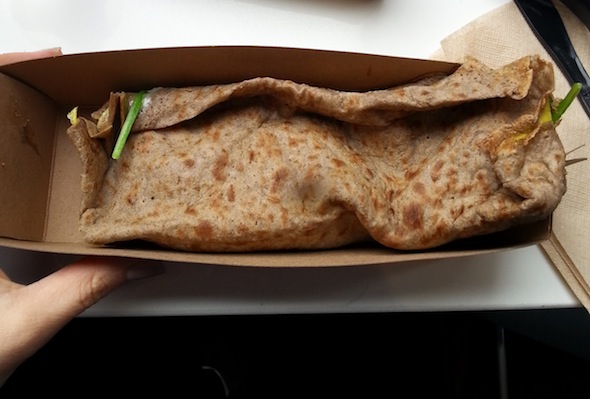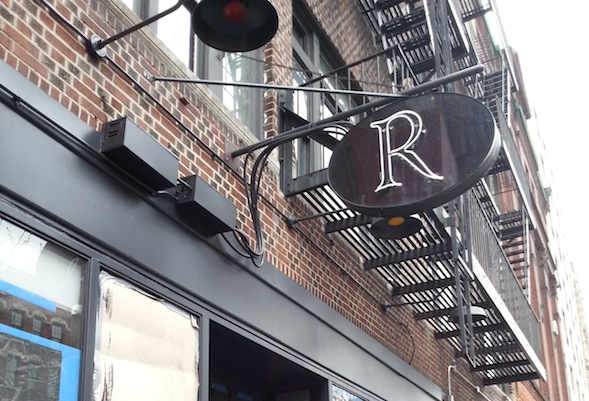Issues: Crepes to go and timeless steak frites

Croissants, baguette and chouquettes served for breakfast at Maison Kayser. Photo: Clemence Michallon.
With its tall buildings and construction work obstructing the road, Chambers Street has little in common with the charming postcard version of Paris. But at By Suzette, a creperie a couple of blocks away from City Hall, two cooks pour batter onto hot pans, dressed in striped Breton shirts and red berets.
Andy Rodrigues and Guillaume Blanchard, the 24-year-old founders of By Suzette, met in business school, in Paris, and decided to launch a food business while watching the French version of “Kitchen Nightmares”. By Suzette opened in April 2014 and within two months, the small shop was making money. It currently sells 2,500 crepes a week on average, at 12 dollars for a meal that includes two crepes – one savory, one sweet.
Rodrigues and Blanchard’s crepe venture comes at a time when French food does not seem as popular as it used to be in the city. In January 2015, Eater published a roundup of 38 essential New York restaurants, and only four French eateries made the cut. Balthazar, the Soho bistro once referred to as “Paris in New York” by restaurant critic Gael Greene, is the oldest of the bunch, and has been around since 1997. The other three opened after 2008: Daniel Boulud’s Bar Boulud, right across the Lincoln Center, Andrew Carmellini’s Lafayette in Noho, and Le Relais de Venise L’Entrecôte, the midtown branch of a French steakhouse franchise.
When Dorothy Cann Hamilton founded the International Culinary Center (ICC) in New York, more than 30 years ago, it was called the French Culinary Institute, modeled after the top cooking school in Paris, with a curriculum based on traditional French techniques. In 2007, a professional Italian course was created, and a Spanish course followed in 2012, the same year that the school was renamed the ICC.
“Nobody wanted to come to the French Culinary Institute to study Italian cooking,” Hamilton says with a chuckle. “It was time to change the name of the school to something more embracing of what actually is happening in the world today.”
French food, Hamilton says, is not as exciting to New Yorkers as it once was. People used to eat out to celebrate special occasions. Now, she says, they eat out for convenience, which doesn’t mean a traditional three-course French meal.
“Thirty years ago, most people had a traditional job from nine to five,” she says. “Today, how many freelancers work at home? How many people work shifts? It isn’t like everyone’s ready to dine at 7:30 or 8 o’clock.”
Because it relies heavily on quality ingredients and animal protein, French cuisine is not the most profitable option for restaurateurs.
“There is no balancing factor like pasta to offset the cost of a menu,” Hamilton says. It can be hard for French food to compete with Italian cuisine and its slew of tasty but considerably cheaper dishes like pasta carbonara.
Yet, chefs still enjoy serving French food. In their 2015 culinary forecast, the National Restaurant Association and the American Culinary Federation asked more than 1,000 chefs to rate French cuisine as either a “hot trend,” “yesterday’s news” or a “perennial favorite.” Only 21% deemed it a “hot trend,” while 34% saw it as “yesterday’s news.” The majority, though, named it a “perennial favorite” – the category accounted for 45% of all votes.
Shane McBride, the current chef at the almost 18-year-old Balthazar, took over the kitchen five years ago. He says a big part of Balthazar’s success – it still appears on lists like Eater.com’s 38 essential New York restaurants – is consistency.
“If somebody came ten years ago, had a great time and had French onion soup and a steak frites, we want them to be able to come back here and have the same experience,” he says. Although part of Balthazar’s menu changes seasonally, McBride was told certain items were not to be tweaked. The “untouchables,” as they are called, include the goat cheese tart, the Balthazar salad (a combination of haricots verts, asparagus, fennel, ricotta and truffle vinaigrette), and the salad niçoise.
Back on Chambers Street, By Suzette’s crepes may taste like their French counterparts, but they bear little resemblance to them. In France, crepes are typically sold on the streets, where food trucks deliver them in paper cones, ready to eat. At By Suzette, crepes come in packaging that was specially designed to keep them warm for 30 minutes, according to Rodrigues.
When French customers order crepes to go, they usually eat them right away. New Yorkers are likely to bring their food back to the office before they dig in, Rodrigues says. By Suzette’s packaging also facilitates deliveries, through websites such as Seamless and Grubhub.
Rodrigues and Blanchard monitored American selling techniques before they opened By Suzette. They noticed people loved to customize their burritos at Chipotle, and included a “build your own crepe” on By Suzette’s menu, which has turned out to be more popular than 20 set combinations.
Rodrigues knows health is a determining factor when New Yorkers choose their meals. He eats healthier now than he did in France – “no more Nutella, way more fruit and vegetables.” French savory crepes, as it turns out, are well adapted to New Yorkers’ demands. They are made with buckwheat flour, which is naturally gluten-free, making them a popular choice for those on special diets.
Rodrigues and Blanchard also priced the crepes to strike a balance between what they needed to generate profit and what they thought customers would be willing to pay. Higher prices, Rodrigues says, would have looked “too French.”
“We didn’t want to attract white collars only,” he says. “We wanted to include everyone, down to students.”
Seeming too pretentious is a common pitfall for French eateries, according to McBride. A year ago he became the co-chef of Cherche Midi, a new French restaurant (with frog’s legs on the appetizers menu), in addition to his work at Balthazar, which is just a few blocks away. Far from experiencing French fatigue, the neighborhood’s locals welcomed the addition, he says, because all of the other French restaurants had closed – 2004 in particular was a tough year for French eateries in New York City, with the closings of institutions like Lutèce, La Caravelle and La Côte Basque, which had all operated for more than 40 years.
“French food was perceived as fancy, expensive – suit and tie food,” he says. “Real, good French food doesn’t need to be that at all. It’s the food of peasants, the good stuff.”
A short walk away from Cherche Midi, customers line up at the Dominique Ansel Bakery, probably best known for the Cronut, a cross between a croissant and a donut. His name has become synonymous with hybrid desserts, which came in fourth in the top five dessert trends of the 2015 culinary forecast.

Pastries at the Dominique Ansel Bakery – including Paris-NY (Ansel’s version of the Paris-Brest), at the center. Photo: Clemence Michallon.
Not long after 11 am on a Friday morning, three different customers ask for Cronuts in a ten-minute period, but regulars know their request is hopeless: the store ran out a long time ago. The woman behind the counter advises them to come back another day, much earlier – two years after the launch of the Cronut, people still line up as early as 6 a.m outside of the bakery to buy them.
Ansel was born and raised in France, learned his craft as a teenager in French bakeries and enrolled as a military cook for three years in French Guyana. He moved to New York in 2006 to work as the executive pastry chef for Daniel Boulud, and opened his own bakery in Soho.
Americanized croissants (or Frenchified donuts) are not the only key to Ansel’s success. He seems to understand what Americans prefer, and is willing to tweak traditional French recipes to appeal to their tastes. That is why he developed his own version of the kouign-amann, a traditional pastry from Brittany made with dough, sugar, and lots of butter.
“Kouign-amann is very heavy and rustic. I wanted something a bit more delicate and lighter,” Ansel says. “This led to us reducing the sugar and butter ratio by about a half in our recipe. People prefer slightly lighter tastes these days. They are working in an office and no longer out in a farm or doing much manual labor.”
Ansel’s version of the kouign-amann was born, and became the DKA (Dominique’s Kouign Amann) – a popular backup order when the bakery has run out of Cronuts.
Some French classics resist translation. Zohair Benchakroun, one of the co-founders of La Maison du Croque-Monsieur, knows it. His restaurant, a small shop near Union Square, serves various versions of the croque-monsieur, a French classic that typically involves toasted bread, ham and melted cheese.
“Normally, the croque-monsieurs are very small. Americans are used to bigger portions, Benchakroun says. “We decided to make them bigger, with more ingredients.” In addition to the classic triad of ham, cheese and béchamel sauce, La Maison du Croque Monsieur developed its own “new croques,” with toppings ranging from roasted turkey to bresaola, Portobello mushrooms and ratatouille, and even “sweet croques” with decadent combinations like bananas, Nutella and mascarpone.

Mr. Gore’s toppings include portobello mushrooms, sundried
tomatoes, pine nuts and goat cheese. Photo: Clemence Michallon.
But not every French restaurateur is willing to part with traditions to appeal to American customers. Lionel Bremond opened Café Paulette, a small French café in Fort Greene, Brooklyn, in September 2013. Cookbooks like “Paris mon Amour,” “French Bistro” and “The Provençal Cookbook” sit on shelves above the bar stools and classic French pop plays from the speakers, down to seventies idol Claude François.
Bremond adapts to the demands of his American customers, 90% of them locals, he says. But he has limits: he stopped making deliveries through Seamless in January, even though that meant losing some business.
“Our cuisine doesn’t travel well,” he says. “I think it’s strange to have escargots delivered. It’s doable, but the temperature is different, and the presentation is not the same.”
Back at By Suzette, a mechanical voice announces: “New Seamless order” every ten minutes or so, and a bicycle is parked in front of the shop, ready for deliveries. Rodrigues and Blanchard have plans to open five new By Suzette shops, three in Manhattan and two in malls in New Jersey and Philadelphia.
Spring could be a promising time for French restaurants in New York. Two of them made it into Eater’s list of the 23 most anticipated new establishments in the city for the season: Rebelle and La Gamelle, located almost directly across from each other on Bowery. The third one is Ansel’s new bakery in the West Village, the Dominique Ansel Kitchen, which runs as a restaurant kitchen and serve desserts made to order.
McBride spent ten days in France in February doing research for a future restaurant in the financial district. He cannot tell yet what French classics will be on the menu (“those are secrets”), but he knows this new restaurant will be “even more French” than Cherche Midi.
“I have done French food half of my life. It’s food I have grown up to love, because I have been cooking it for so long,” he says. “And even though I’ve cooked it for as long as I have, I still like to have a cup of French onion soup every once in a while.” This particular French dish, he says, is both simple and soul warming.
Tags: by suzette, crepe, cronut, dominique ansel, french food


Your Comments